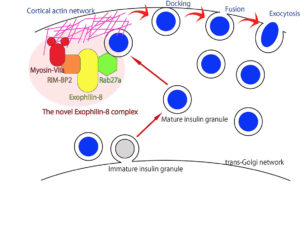Fushun Fan1*, Kohichi Matsunaga1*, Hao Wang1, Ray Ishizaki1, Eri Kobayashi1, Hiroshi Kiyonari3,4, Yoshiko Mukumoto4, Katsuhide Okunishi1, and Tetsuro Izumi1,2 1 Laboratory of Molecular Endocrinology and Metabolism, Department of Molecular Medicine, Institute for Molecular and Cellular Regulation, and 2 Research Program for Signal Transduction, Division of Endocrinology, Metabolism and Signal Research, Gunma University Initiative for Advanced Research, Maebashi 371-8512, Japan 3 Animal Resource Development Unit, and 4 Genetic Engineering Team, RIKEN Center for Life Science Technologies, 2-2-3 Minatojima Minami-machi, Chuo-ku, Kobe 650-0047, Japan (* These authors contributed equally to this work)
About
Insulin is produced and stored in secretory granules in by pancreatic β cells. Secretion of insulin requires a series of membrane dynamics, namely, producing granules from the Golgi apparatus, protein sorting to granules and maturation, and trafficking and fusion to the plasma membrane. Secretory granules transfer to the actin cortex at the cell periphery before they fuse with plasma membrane. The Exophilin family proteins, originally identified by Dr. Izumi’s lab (Laboratory of Molecular Endocrinology and Metabolism in IMCR) as the effectors of the small GTPase Rab27, regulate a series of secretory granule trafficking and exocytosis. In the present study, we found that mice lacking one of Exophilins, Exophilin-8, show significantly higher blood glucose level, and that Exophilin-8-null pancreatic β cells exhibit decreased insulin secretion due to loss of insulin granules located at the F-actin-rich cell periphery. We further showed that Exophilin-8 forms a complex with RIM-BP2 and Myosin-VIIa, and that this complex formation is pivotal for the localization and exocytosis of granules beneath the plasma membrane. These findings provide the molecular basis correlating the physical location of secretory granules with their functional pool. Genetic or functional alterations of the complex may lead to type 2 diabetes and other secretory disorders in humans.
Paper information
Exophilin-8 assembles secretory granules for exocytosis in the actin cortex via interaction with RIM-BP2 and myosin-VIIa
Fushun Fan, Kohichi Matsunaga, Hao Wang, Ray Ishizaki, Eri Kobayashi, Hiroshi Kiyonari, Yoshiko Mukumoto, Katsuhide Okunishi, and Tetsuro Izumi
eLife.2017;6:e26174. DOI: 10.7554/eLife.26174
Online URL
https://elifesciences.org/articles/26174







